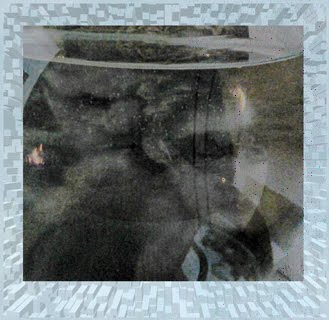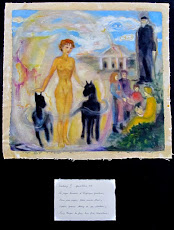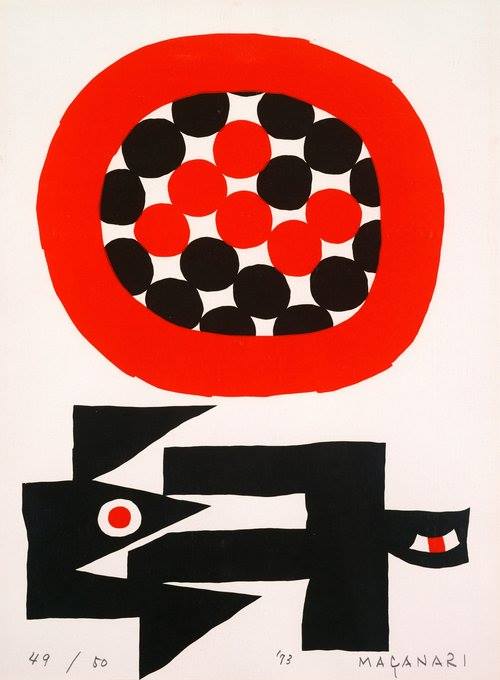 |
| From left to right: a detail from Messenger, 1996; Dan Adler, Liz Magor and Lesley Johnstone taking us on a tour of the exhibition. / De gauche à droite: un détail de Messenger, 1996; Dan Adler, Liz Magor et Lesley Johnstone qui nous guident durant la visite de l'exposition. Photos © Lena Ghio, 2016 |
HABITUDE
•Français en bleu
This summer you can see the intriguing sculptures from renowned Canadian artist Liz Magor at the Montreal Museum of Contemporary Art. The abundant nature of Magor's work demanded the collaboration of two curators: Lesley Johnstone, Curator and Head of Exhibitions and Education at the MAC and Dan Adler, Guest Curator and Professor at York University in Toronto. Indeed, when I walked into the exhibition, the first impression I got was associated with the immense work Production, 1980, an installation that is composed of approximately 2 500 hand made bricks laid out on the first wall. There is a chair that holds an antique brick press that the artist used to mold the bricks. I was taken aback by the textured details of each brick made from recycled newspapers. It made me think of a prison. The chair holding the press became an electric chair for a brief moment before I understood what I was looking at. Oddly, this piece is an apt metaphor for the creative process of the extraordinarily prolific artist who is constantly at odds with her anxiety about the contemporary human condition. I could easily imagine that her repetitive gestures while creating this work allowed her to reach a Zen like state.
You will see a large variety of artworks that use everyday material she found in her surroundings: empty bottles, cigarettes, pieces of food, old blankets, sculptures, on and on as she reweaves new tales from these cast out objects. One of my favorite pieces is Sowing Weeds in Lanes and Ditches, 1976. It is an intricate shelf filled with envelopes of dried herbs, seeds, pots, tools. I enjoyed its earthy tones and that it appeared from another era. The exhibition is a loosely constructed retrospective of over forty years of production. The decision was to assemble the pieces in an intuitive way to allow visitors to connect with their own insights. There is a comprehensive catalog that accompanies the show and it will help you remember and understand the hidden meaning of certain pieces.
FRANÇAIS
Cet été vous pourrez voir les intrigantes sculptures de l'artiste Canadienne de renom Liz Magor au Musée d'art contemporain de Montréal. La nature abondante de l'oeuvre de Magor a exigé la collaboration de deux commissaires: Lesley Johnstone, conservatrice et chef des expositions et de l'éducation au MAC et Dan Adler, conservateur invité et professeur agréé d'histoire moderne et contemporaine de l'art à l'Université York de Toronto. En effet, quand je suis entrée dans l'exposition, la première impression que j'ai eue associée à l'immense pièce Production, 1980, une installation qui est composée d'approximativement 2 500 briques faites à la main et étalées sur le premier mur. Il y a une chaise qui supporte la presse à brique dont s'est servi l'artiste pour mouler ces briques. J'ai été déconcertée par les détails texturés de chaque brique produite avec du papier journal recyclé. Cela m'a fait penser à la prison. La chaise qui tenait la presse est devenue une chaise électrique pendant un bref moment avant que je saisisse ce que je regardais. Étrangement, cette pièce est une métaphore pertinente du processus créateur de l'artiste qui est en conflit constant avec son anxiété concernant la condition humaine contemporaine. Je pouvais facilement imaginer que ses gestes répétitifs alors qu'elle créait cette oeuvre lui permettaientt d'atteindre un état Zen.
Vous verrez une large variété d'oeuvres d'art érigées à partir des matériaux du quotidien qu'elle a trouvé dans son environnement: bouteilles vides, cigarettes, morceaux de nourriture, vieilles couvertures, sculptures, sans arrêt alors qu'elle retisse des nouvelles narratives de ces objets rejetés.
Une de mes oeuvres favorites est Sowing Weeds in Lanes and Ditches, 1976. C'est une étagère chargée d'enveloppes contenant des herbes sèches, des semences, des pots, des outils. J'ai apprécié ses tons de terre qui lui donnait l'allure d'appartenir à un autre temps.
L'exposition est une rétrospective montée très librement avec un corpus produit en plus de quarante ans. La décision a été d'assembler les pièces de façon intuitive ce qui permettrait au visiteur de connecter avec sa propre perspicacité. Un catalogue compréhensif accompagne l'exposition et il vous aidera à vous souvenir et mieux comprendre les messages cachés de certaines pièces.
 |
| Lizzie Fitch & Ryan Trecartin: Priority Infield detail/détail. Photos © Lena Ghio, 2016 |
RYAN TRECARTIN
PRIORITY INNFIELD
2013
•Français en bleu
Mark Lanctôt has curated this show that echoed last year's excellent Jon Rafman's show that he also curated. The big theme of both these exhibitions concerns an exploration of the way technology and the Internet have, and are still, reordering human subjectivity. Lizzie Fitch and Ryan Trecartin have been collaborating since 2000 and are already well-established artists. I was very intrigued by the clips I had seen of their work that appeared chaotic and aimless at first. I was astonished to realize that early on Ryan Trecartin began by asking himself the quintessential questions that every thinking human has addressed: Who are we? Where do we come from? Do we have free will? Where are we going? For me, this made the difference in how I approached what was presented to me throughout the exhibition or else it would be a banal manifestation of youthful belligerence. So I asked Mark Lanctôt to speak to me about that initial questioning by the filmmaker. I understood his answer as being that instead of answering the questions philosophically, the artists are battling through them with their work.
For me the work is not fun, it is not interesting per se, but it is promising. Current culture expects too much from young artists. Even if they have the Internet and so on, only time and life experience will deepen their work. The installation of the works divided into sculptural individual stages reminded me of a colosseum or a fair where many things are going on at once. However, the set up is intelligent and you will be able to comfortably experience each presentation.
INFORMATION
FRANÇAIS
Mark Lanctôt est le commissaire de cette exposition qui fait écho à l'excellente exposition de Jon Rafman de l'année passée dont il a aussi été commissaire. Le grand thème de ces deux expositions concerne l'exploration des voies par lesquelles la technologie et Internet ont réordonné, et continue à réordonner, la subjectivité humaine. Lizzie Fitch et Ryan Trecartin collaborent depuis 2000 et sont déjà des artistes bien établis. J'étais très intriguée par les clips que j'avais vu de leur travail qui m'apparaissait chaotique et sans but au début. J'ai été impressionnée d'apprendre que très tôt dans sa pratique Ryan Trecartin se posait les questions quintessentielles que chaque humain qui pense se pose: Qui sommes-nous? D'où venons-nous? Avons-nous un libre arbitre? Où allons-nous? Pour moi, cela a fait la différence dans mon approche face à ce qu'on me présentait comme exposition sinon cela m'aurait paru comme une manifestation banale de la belligérance de la jeunesse. J'ai donc demandé à Mark Lanctôt de me parler au sujet de ces questionnements initials de la part du cinéaste. J'ai interprété sa réplique dans le sens où les artistes, au lieu de tenter de répondre à ces questions par la philosophie, combattent avec celles-ci au travers leur travail.
Pour moi l'oeuvre n'est pas plaisante, ni intéressante comme telle, mais elle est prometteuse. La culture contemporaine attend trop de la part des jeunes artistes. Même s'ils ont Internet et tout, c'est seulement le temps et les expériences de la vie qui approfondiront leur travail. L'installation des oeuvres est divisée en théâtres sculpturaux qui me rappellent un colisé ou une foire où plusieurs choses se passent en même temps. Cependant, l'organisation est intelligente et vous pourrez vivre l'expérience de chaque présentation comfortablement.
INFORMATION
-LENA GHIO

























No comments:
Post a Comment